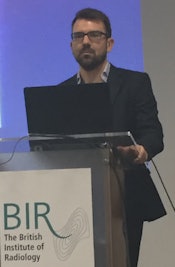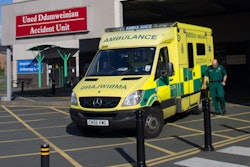
Unprecedented pressures and the constant struggle to tackle the seemingly endless reporting backlog are contributing to a sustained rise in the number of litigation claims involving radiology, but the number of legal cases remains small, a U.K. study has found.
"With year-on-year increases in demand across all aspects, coupled with chronic staff shortages, recruitment crises, and planned retirements of almost 25% of the workforce in the next five years, it is difficult to see how the situation will improve any time soon," noted Dr. Oliver Hulson, a consultant radiologist at Leeds Teaching National Health Service (NHS) Trust (Clinical Radiology, October 2018, Vol. 73:10, pp. 893-901). "Outsourcing and teleradiology companies have gone some way to mitigate waiting times for radiology reports but not at insignificant costs."
He analyzed claims from the U.K.'s National Health Service to identify trends and provide advice to radiologists. He found the cost of claims rose from 400 million pounds (458 million euros) in 2006 to 1.6 billion pounds (1.83 billion euros) in 2016.
Types of claims
Hulson sifted through data from the now defunct NHS Litigation Authority (NHSLA) to identify common themes in claims related to radiology and, hopefully, avoid the possibility of these occurring in the future.
 Dr. Oliver Hulson from Leeds.
Dr. Oliver Hulson from Leeds.Even though claims are on the rise, he found the numbers remain relatively small when comparing the radiology claims with the number of studies performed. In 2016 to 2017, the number of radiology examinations increased 3% from the year before to just over 42 million examinations, according to the Diagnostic Imaging Dataset provided annually by NHS England. This roughly equates to one successful litigation claim for approximately every 500,000 studies performed.
"Claims are rising at a faster rate, year on year, than the NHS budget increase and are predicted to continue to do so," Hulson summarized. "That said, when considering radiology claims as a proportion of the number of radiology studies performed each year in the U.K., the numbers are extremely small. [Roughly] one successful litigation claim for approximately every 500,000 studies performed."
The NHSLA provided the data under the Freedom of Information Act in two distinct cohorts: from 1995 to 2010 and 2011 to 2014. All told, 791 settled claims were recorded by the NHSLA in which radiology was implicated as the primary specialty at fault. For the most part, a year-on-year increase was seen for the dataset. In addition, despite a three- to five-year lag between the reporting of such claims and the data only being provided late in 2015, the number of claims in the year 2013 to 2014 was already higher than any previous year on record, and data from previous years would suggest that a significant number of claims are still to be filed.
| Cause of claims in the U.K. | |||
| Portion of claims | Total cost of claims | Mean claim amount | |
| Alleged missed/diagnosis of a tumor | 29% (n = 174) |
15 million pounds (17 million euros) | 80,000 pounds (92,000 euros) |
| Chest x-ray | 26% | ||
| CT | 25% | ||
| Mammography | 15% | ||
Of the claims, 136 related to a delayed diagnosis, and a specific time frame was given for 60 of these. The mean length of delay to diagnosis was 113 days, ranging from 60 days to 2,190 days.
Hulson, an interventional radiologist, found the claims for this specialist area were small in number, with 63 claims totaling 4.3 million pounds (4.8 million euros) with a mean claim amount of 63,110 pounds (71,087 euros). The number of claims was too small to characterize any trends, he added.
Injuries also occurred within the radiology department: 75 claims (9.5%) totaling 1.4 million pounds (1.6 million euros) in the range of 500 pounds to 93,172 pounds (563 euros to 104,949 euros). Of these, 22 (29%) were due to a fall in the department, and three claims relating to patients undergoing MRI despite having a pacemaker (4,116 pounds/4,636 euros) were settled. Two other cases involved an oxygen cylinder being present between the patient's legs (11,762 pounds/13,428 euros), and one patient had not removed his hearing aids before the scan (1,200 pounds/1,351 euros).
Learning important lessons
Nobody is perfect and mistakes happen, but sometimes those mistakes are fatal and/or can result in medical litigation claims, according to Hulson. The most important part is what comes after them, and he urges radiologists to learn from their mistakes to mitigate and reduce liability.
"Errors are inevitable in all facets of medicine, but unlike some of our clinical colleagues, radiological discrepancies are catalogued and archived for all to see for years to come," he wrote.
It is vital that the current workforce can work productively yet safely and effectively. Errors occur more frequently when radiologists are required to read more than 20 studies a day, according to Hulson. Plus, there's decision fatigue to account for, which arises due to the nature of often repetitive, continuous, complex decision-making.
"Eventually, we respond to this fatigue by taking shortcuts and make diagnostic assumptions, ultimately leading to poor judgment and potential diagnostic discrepancies," he wrote. "Radiologists need to take regular breaks, be aware of one's reporting limits, and recognize when fatigue may be an issue."
Also, systems that aid in swift reporting will help address the issue -- highlighting and escalating unexpected or significant findings will go a long way to improving the situation, he noted. Ensure things don't fall through the cracks by requiring general practitioners to confirm receipt of reports, for example.



















